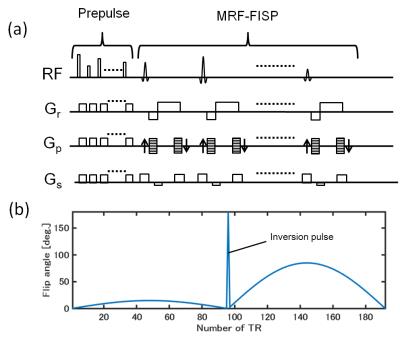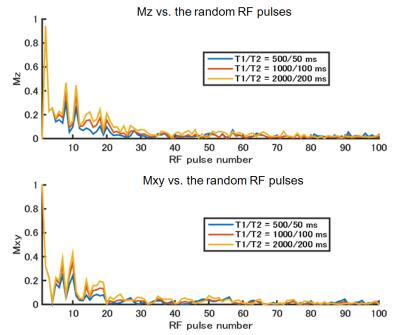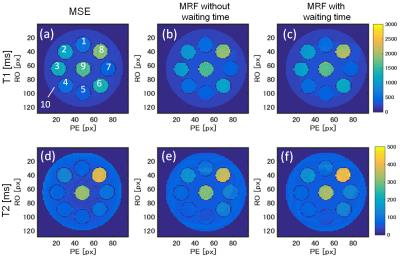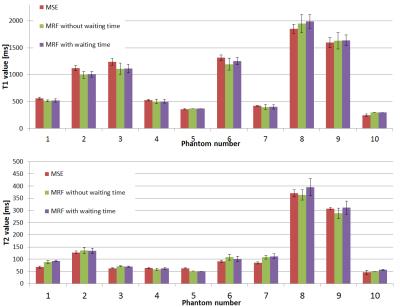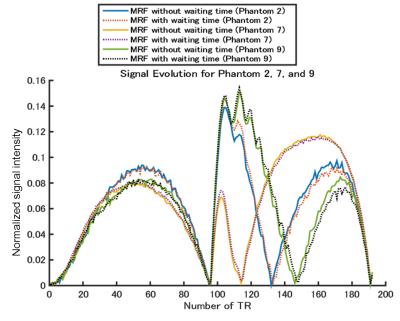5058
Fast and robust magnetic resonance fingerprinting with Cartesian sampling using random RF and gradient spoilers to reset the longitudinal and transverse magnetization1Toshiba Corporation, Kawasaki, Japan, 2Toshiba Medical Systems Corporation, Otawara, Japan
Synopsis
A prepulse for resetting longitudinal and transverse magnetization is proposed in order to accelerate magnetic resonance fingerprinting (MRF) with Cartesian sampling. A pulse sequence was developed based on a steady-state free precession sequence in which the prepulse consists of a set of radio frequency (RF) pulses and gradient spoilers. Simulation and experimental results demonstrated that the prepulse enables fast MRF in the presence of additional sequence modules, such as respiration triggering.
INTRODUCTION
Magnetic resonance fingerprinting (MRF) is a new approach for quantitative mapping of tissues, such as T1 and T2 mapping, achieved by matching an acquired signal evolution with a pre-calculated dictionary [1]. MRF with a Cartesian trajectory offers robust imaging in the presence of off-resonance effects and hardware imperfections, although a spiral trajectory was used for MRF in many previous studies. However, a long relaxation time, which is required in order to wait for longitudinal magnetization (Mz) recovery, leads to long scan times for MRF with Cartesian sampling. To avoid the waiting time, Chen at al. [2] proposed MRF with a balanced steady-state free precession sequence using a saturation recovery method to reset the transverse magnetization (Mxy). Amthor et al. [3] proposed a signal matching method for MRF with a steady-state free precession sequence (MRF-FISP [4]) using a dictionary in consideration of steady-state magnetization with a short waiting time. Both these methods are based on the idea of using a steady-state signal evolution with gradient spoiling to eliminate Mxy. Therefore, a recalculation of the dictionary is required for MRF measurements with an additional sequence module such as motion navigator or respiratory/electrocardiogram triggering, which may alter the steady-state magnetization of Mz.
In this paper, we propose a prepulse to reset the longitudinal and transverse magnetization using a set of random RF pulses and gradient spoilers for MRF-FISP with Cartesian sampling to shorten the waiting time. Simulation and experimental results demonstrated that the signal evolution acquired using the proposed prepulse is robust to additional sequence modules.
METHODS
A pulse sequence was developed based on a two dimensional MRF-FISP with a prepulse consisting of a set of RF pulses and gradient spoilers as shown in Figure 1 (a). The series of RF pulses have pseudo-random amplitude (from 0° to 90°) and phase (from 0 to 2π) values. In this study, 50 pulses were applied at intervals of 6 ms before each MRF-FISP repetition. The total time required for the prepulse was 300 ms. The MRF-FISP was repeated with fixed TR and TE of 13.7 and 4.0 ms, respectively. A train of sinusoidally varying 192 flip angles with an inversion pulse was used as shown in Figure 1 (b).
A dictionary for MRF reconstruction was generated using an extended phase graph approach [5]. An initial Mxy and Mz of zero, instead of an equilibrium magnetization, were used for the dictionary. The dictionary consists of 25 T1 values (100-2500 ms in 100 ms increments) and 20 T2 values (10-1000 ms in 50 ms increments).
A Bloch simulation was implemented to show the magnetization change caused by the prepulse. A series of 100 random RF pulses and gradient spoilers was applied.
Phantom experiments were performed to demonstrate the accuracy of the proposed method using a clinical 3-T MRI scanner (Titan 3T Saturn Gradient Option, Toshiba Medical Systems). A matrix size of 128 × 96, and a slice thickness of 8 mm were used. The phantom consisted of 10 uniform materials with different relaxation times. The T1/T2 value of each was measured using multiple spin echoes (MSE) and MRF with the prepulse. To show the robustness of the prepulse to an additional sequence module, MRF experiments were conducted with and without a relaxation waiting time of 5 s before each repetition. The total scan times with and without the wait times were 14:39 and 4:51, respectively.
RESULTS AND DISCUSSION
The Mz and Mxy intensities induced by the pseudo-random RF pulses are shown in Figure 2 (a) and (b), respectively. As the number of RF pulses was increased, the magnetization asymptotically approached zero.
Figure 3 (a)-(f) shows the T1 and T2 maps measured using MSE and using MRF with and without the waiting time. T1 and T2 values of the results are shown in Figure 4. The phantom numbers in Figure 4 correspond to those in Figure 3. The T1 and T2 values measured using MRF agreed well with those measured using MSE.
Figure 5 shows the signal evolutions acquired using MRF. The signal evolution acquired with the prepulse was independent of the magnetization status before the first excitation pulse of the flip angle train. These results imply that the prepulse enables MRF that is robust to arbitrary sequence modules without recalculation of the dictionary.
CONCLUSION
The prepulse to reset the magnetization for MRF was proposed. Simulation and experimental results showed that the prepulse enabled fast MRF with Cartesian sampling because no waiting time for magnetization recovery is required. In addition, another important advantage was demonstrated, namely, robustness to additional sequence modules.Acknowledgements
No acknowledgement found.References
[1] Ma, D., et al. "Magnetic resonance fingerprinting." Nature 495.7440 (2013): 187-192.
[2] Amthor, T., et al., “Steady-State Magnetic Resonance Fingerprinting”, ISMRM 2016, 4225
[3] Chen, X., et al., “Multi-shot Magnetic Resonance Fingerprinting using Saturation Recovery Preparation Pulse”, ISMRM 2016, 4297
[4] Jiang, Y., et al. "MR fingerprinting using fast imaging with steady state precession (FISP) with spiral readout." Magnetic resonance in medicine 74.6 (2015): 1621-1631.
[5] Hennig, J. "Multiecho imaging sequences with low refocusing flip angles." Journal of Magnetic Resonance 78.3 (1988): 397-407.
Figures
